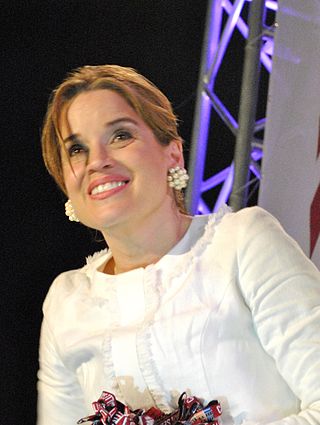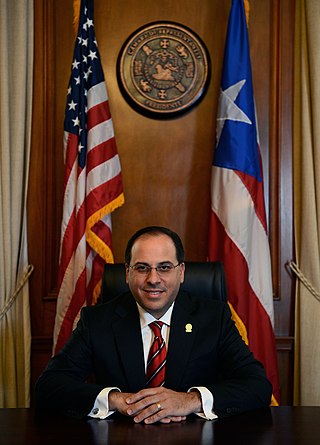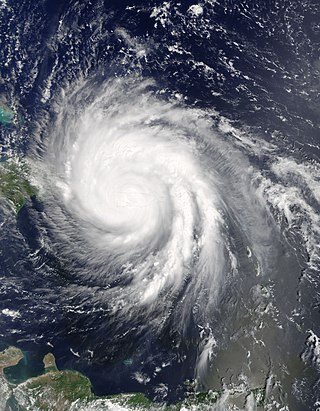
Vieques, officially Isla de Vieques, is an island and municipality of Puerto Rico, in the northeastern Caribbean, part of an island grouping sometimes known as the Spanish Virgin Islands. Vieques is part of the Commonwealth of Puerto Rico, and retains strong influences from 400 years of Spanish presence in the island.

Isla Culebra is an island, town and municipality of Puerto Rico and geographically part of the Spanish Virgin Islands. It is located approximately 17 miles (27 km) east of the Puerto Rican mainland, 12 miles (19 km) west of St. Thomas and 9 miles (14 km) north of Vieques. Culebra is spread over 5 barrios and Culebra Pueblo (Dewey), the main town and the administrative center of the island. Residents of the island are known as culebrenses. With a population of 1,792 as of the 2020 Census, it is Puerto Rico's least populous municipality.

Vieques Air Link is a small Puerto Rico-based airline that links Vieques with Culebra and mainland Puerto Rico.

Pedro Juan Rosselló González is a Puerto Rican physician and politician who served as the governor of Puerto Rico from 1993 to 2001. He was President of the New Progressive Party from 1991 to 1999 and 2003 to 2008, and served as Senator for the District of Arecibo from 2005 to 2008. His son, Ricardo, was also Governor of Puerto Rico from 2017 to 2019.

Fajardo is a town and municipality-Fajardo Combined Statistical Area.

Ceiba is both a small town and a municipality in northeast Puerto Rico. It is named after the famous Ceiba tree. Ceiba is located in the north-east coast of the island, bordering the Atlantic Ocean, south of Fajardo, north of Naguabo and southeast of Río Grande. Located about one hour's driving distance from San Juan, Ceiba is spread over 7 barrios and Ceiba Pueblo. It is part of the Fajardo Metropolitan Statistical Area.

Morovis is a town and municipality of Puerto Rico located in the central region of the island, north of Orocovis, south of Manatí, Vega Baja and Vega Alta; east of Ciales, and west of Corozal. Morovis is spread over 13 barrios and Morovis Pueblo. It is part of the San Juan-Caguas-Guaynabo Metropolitan Statistical Area.

Germán Rieckehoff Sampayo was a Puerto Rican nationalist of German descent, who served as president of the Puerto Rico Olympic Committee.

Puerto Rican literature is the body of literature produced by writers of Puerto Rican descent. It evolved from the art of oral storytelling. Written works by the indigenous inhabitants of Puerto Rico were originally prohibited and repressed by the Spanish colonial government.

The Vieques, Puerto Rico, Naval Training Range was a United States naval facility located on the island of Vieques, about 5 miles east of mainland Puerto Rico. Starting in November 1941, the navy used the range for military exercises. Military operations ended in 2001, with the Navy completely leaving the area in 2003.

Isabel II barrio-pueblo(referred to as Isabel Segunda in Spanish) is a barrio and the administrative center (seat) in the downtown area in the island-municipality of Vieques, Puerto Rico. Its population in 2010 was 1,354.

Carmen Yulín Cruz Soto is a Puerto Rican politician who served as mayor of the city of San Juan, Puerto Rico from 2013 to 2020. From 2009 through 2013, Cruz served in the House of Representatives of Puerto Rico.

Jaime R. Perelló Borrás is a Puerto Rican politician. Perelló is affiliated with the Popular Democratic Party of Puerto Rico and the Democratic Party of the United States. He was the 30th Speaker of the House of Representatives of Puerto Rico.

The recorded history of Puerto Rican women can trace its roots back to the era of the Taíno, the indigenous people of the Caribbean, who inhabited the island that they called "Boriken" before the arrival of Spaniards. During the Spanish colonization the cultures and customs of the Taíno, Spanish, African and women from non-Hispanic European countries blended into what became the culture and customs of Puerto Rico.

Hurricane Maria was a deadly Category 5 hurricane that devastated the northeastern Caribbean in September 2017, particularly in the U.S. territory of Puerto Rico, which accounted for 2,975 of the 3,059 deaths. It is the deadliest and costliest hurricane to strike the island of Puerto Rico, and is the deadliest hurricane in terms of category strength to strike the country of Dominica and the U.S. Virgin Islands territory.

From September 19-21, 2017, Hurricane Maria devastated the entire island of Puerto Rico and caused a major humanitarian crisis. Originally, a powerful Category 5 hurricane, Maria was the strongest storm to impact the island in nearly 90 years. Maria made landfall on Puerto Rico on September 20 as a high-end Category 4 storm, bringing a large storm surge, very heavy rains, and wind gusts well above 100 mph (160 km/h). It flattened neighborhoods, crippled the island's power grid, and caused an estimated 2,982 fatalities and US$90 billion in damage.

Wanda Emilia Vázquez Garced is a Puerto Rican politician and attorney who served as Governor of Puerto Rico from 2019 to 2021. Prior to her tenure as governor, she served as the 19th secretary of Justice, from 2017 to 2019. A member of the New Progressive Party and Republican Party of Puerto Rico, Vázquez is the second female governor in Puerto Rican history, after Sila María Calderón. She assumed the office following the resignation of Ricardo Roselló, and the judicial annulation of Pedro Pierluisi's short-lived government, in the aftermath of the Telegramgate Scandal. On August 16, 2020, she failed to secure the New Progressive Party nomination for Governor of Puerto Rico in the 2020 elections, losing to Pedro Pierluisi.

Carmen Irene Maldonado González is a Puerto Rican politician and mayor of Morovis, Puerto Rico. Maldonado is affiliated with the Popular Democratic Party, has been serving as mayor since 2017 and was reelected again in 2020. As of 2019, she is the vice-president of her party.
Events in the year 2020 in Puerto Rico.

The COVID-19 pandemic in Puerto Rico was an ongoing viral pandemic of coronavirus disease 2019 (COVID-19), a novel infectious disease caused by severe acute respiratory syndrome coronavirus 2 (SARS-CoV-2). It is part of the ongoing COVID-19 pandemic.





















